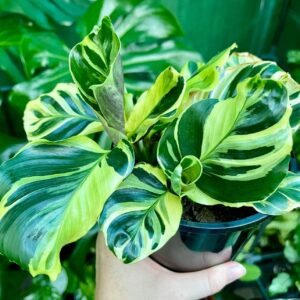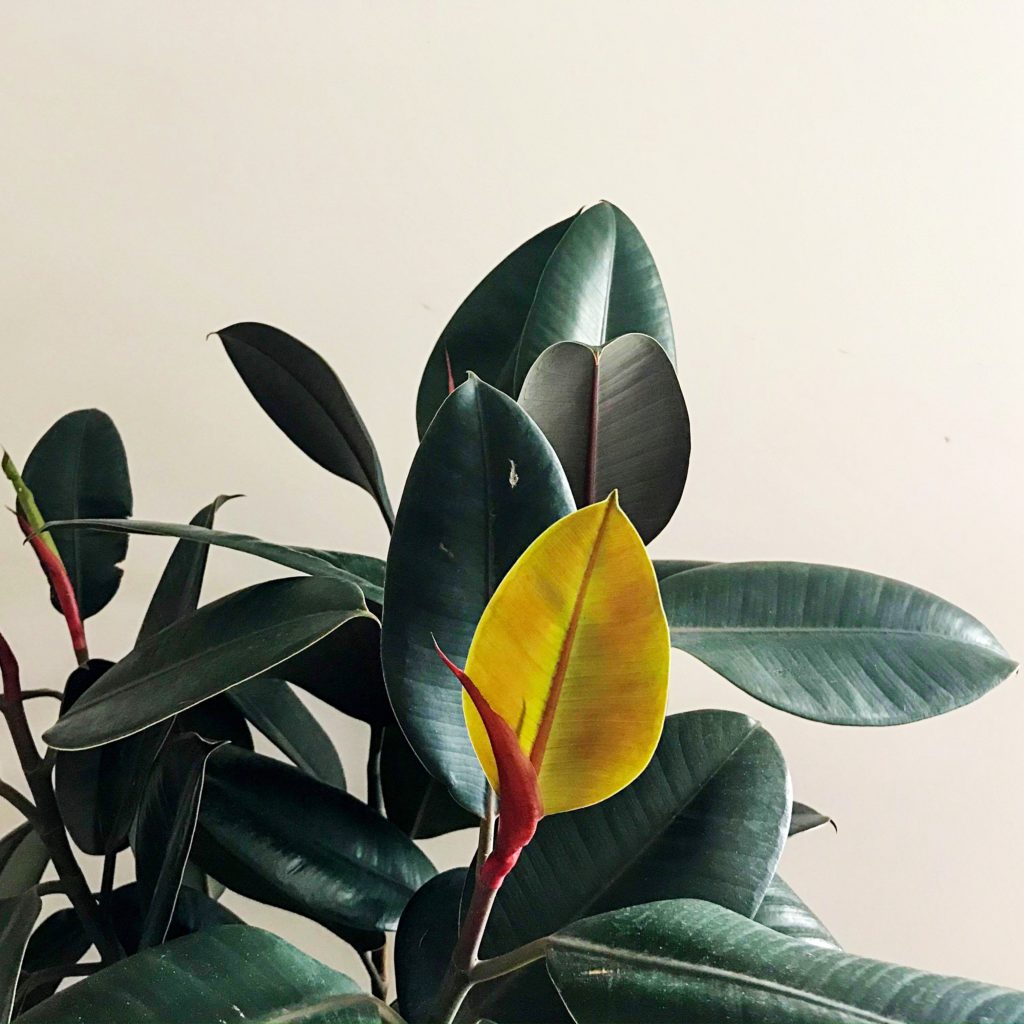Calathea Louisae ‘Thai Beauty’ a.k.a Calathea ‘Thai Beauty’
The Calathea ‘Thai Beauty’ is one of the many gorgeous Calathea plants. This one has striking green, lime green and cream coloured variegated leaves with purple on the underside. In this Article we will cover everything you need to know about caring for your Calathea Louisae.
Like all other Calathea varieties, this one likes high humidity and bright indirect light. Calathea ‘Thai Beauty’ is a newer, must have plant for your collection but be aware, Calathea plants are a little bit tougher to keep happy than some other houseplants.

Calathea ‘Thai Beauty’ Quick Overview
| Full Size | Up to 8 inches |
| Light | Bright indirect light |
| Temperature | 65˚F-85˚F (18˚C-29˚C) |
| Humidity | High |
| Cost | $ |
| Care Level | Medium |
| Toxicity | Non-Toxic |
Size
In the correct living conditions, the mature size of a Calathea Thai Beauty can reach up to 8 inches in length and 4 inches in width. A mature leaf can reach up to 6 inches in length.
Calathea plants tend to go dormant over the cooler months due to temperature and light changes. This means the plant will stop actively growing during those months.
Calathea ‘Thai Beauty’ Light Requirements
Calathea ‘Thai Beauty’ will grow best when in a spot that will receive bright indirect light. In their natural habitat, Calathea plants live on the jungle floors and receive the light the shines through the tree leaves above.
You should avoid direct sunlight as the harsh rays will burn the foliage and lose their vibrant colour. The foliage will also become splotchy or patchy.
Calathea ‘Thai Beauty’ can tolerate low to medium light conditions, however the new foliage may lose some variegation and become more of a green colour. Providing bright indirect light during the cooler months when the plants go into dormancy and sometimes die back, will assist to help maintain growth.
Adding a blind or curtain to your window will help to defuse the harsh sunlight to avoid burning the plants foliage. Alternatively, if you can’t seem to find that perfect spot in your home, you can always use grow lights.
Just like direct sunlight, if your plant is sitting too close to the grow lights, they will burn the foliage. Keeping a safe distance of at least 60cm between your plant and the light will avoid any trouble.
Temperature
The ideal temperature for growing Calathea Thai Beauty is between 65˚F-85˚F (18˚C-29˚C). Like all Calathea plants, this plant loves warm climates and doesn’t like cold temperatures. Mature Calathea plants will struggle growing when temperatures drop below 65ºF (18ºC).
If your plant is kept outside of this temperature bracket for a prolonged period of time, it can cause fungus issues and invite unwanted pests. Exposure to high temperatures can cause the leaves to start curling.
Humidity
Since this plant is native to tropical rainforests, it loves to be in a humid environment. Calathea Thai Beauty will thrive when kept in a high (70%-90%) humidity environment. If your plant is housed in a spot with low humidity, you will notice browning to the edges and tips of the leaves.
You should also keep calathea louisae plants away from cold drafts. It’s best to house your plant in a spot where humidity is naturally higher like in a bathroom.
Providing a high humidity for your plants will encourage bigger and healthier growth. There are a few thing you can do that can help bump up the humidity in your home. The things you can try are:
- Misting your plants (Wipe leaves dry to avoid fungal diseased)
- Pebble trays
- Grouping plants together
- Humidifier
- Terrarium
You can read more about increasing humidity in your home with our humidity tips for indoor plants.
Calathea ‘Thai Beauty’ Watering Requirements
Calathea ‘Thai Beauty’ like to be frequently watered. These plants likes to be kept in a moist (not soggy) soil. You should check the top inch of the soil with your finger to feel if the soil is still moist. If the soil is dry, you can water your plant.
When giving your plant a drink, ensure the water can freely drain away from the bottom of the pot as these plants don’t like to sit in water. You should also try and avoid getting water on the foliage as this can start fungal problems and browning leaves.
Not only do you need to be on top of their watering schedule, Calathea’s can be quite picky with the type of water you use. These plants tend to be quite sensitive to the minerals that are in most tap water and this can cause the foliage to yellow.
To avoid these problems, you can use filtered water, rain water or tap water that has been left out overnight so the chlorine and minerals evaporate out.
Although Calathea Thai Beauty likes moist soil, you need to be cautious of over-watering. Excess water causes the soil to become waterlogged and can start rotting the roots. When the roots have rotted, they no longer take in any nutrients or water.
This can cause fungus issues, pest problems and root-rot. A sign that you may have over-watered your Calathea Thai Beauty are yellowing leaves. Leaves that become brown and crispy around the edges are a sign of under-watering.
Calathea ‘Thai Beauty’ Fertilizing requirements
You should fertilise your Calathea Thai Beauty monthly during Spring and Summer. You should cut down on fertilising during the cooler months (Winter and Autumn) when the plant isn’t actively growing and plant may go into dormancy.
Applying fertiliser while your plants aren’t actively using all the nutrients in the soil can cause salt build up and root burn. Fertilising your plants gives them the essential nutrients they need for maintaining and promoting new and healthy growth.
The best fertiliser to use for Calathea Thai Beauty would be a balanced all purpose liquid fertiliser diluted to half strength. The roots of these plants can be quite sensitive to chemicals and can get damaged if the fertiliser isn’t diluted. You should also try and avoid the cheaper fertilisers that have higher levels of salt. A balanced N-P-K fertiliser will work well with this plant.
When it comes to fertilising houseplants, you need to be cautious of over-fertilising. Over-fertilising your Calathea Thai Beauty can burn the roots and foliage and in some cases cause plant death. Yellow leaves with brown tips can be a sign of over-fertilising.
If you think you have over-fertilised your plant you can either change the soil or rinse the fertiliser out of the soil. You will notice a change in the water colour once the fertiliser has been rinsed out.
Soil Requirements
Calathea Thai Beauty like to be in a rich, peat based well draining soil. To achieve a rich well draining soil, you can use orchid bark potting mix with compost, perlite, charcoal and peat mixed into it to help create drainage and air flow while still holding onto moisture.
Air flow is important in potting soil as it allows the plants roots to breath. Not having enough oxygen to the roots can cause the roots to start rotting. When potting your plant, be sure to use a pot that has drainage holes to avoid soil becoming waterlogged and causing root-rot.
Adding other organic materials like coco coir, mulch chunks and coconut husk to the soil will also help restrain moisture. Calathea Thai Beauty like to be kept in moist soil so it’s important to use ingredients that will help hold moisture in the soil but not keep it soggy. Adding garden compost and mulch can add more richness to the soil.
Diseases & Pests
The common pests you may encounter with your Calathea ‘Thai Beauty’ are Mealybugs, Spider Mites, Thrips, Scale, Fungus Gnats and Aphids. Some of the common diseases that you may encounter are root-rot and Fungal infections.
Keeping your plants happy and healthy in the correct conditions can help to deter most pests and diseases. However, there are a few things you can do that will assist in preventing any pest infestations. The things you can try are:
- Checking new plants for pests or isolating new plants for up to a week.
- Check your plants every few days for pests.
- Trim off any dead or dying leaves.
- Wipe down leaves if you notice them getting dusty.
- Keeping your plants healthy. A healthy plant will be able to handle an infestation better than those that aren’t as happy.
- Isolate any plants that have pests.
Following this will assist in keeping pests away as well as catch them early on before any severe infestations are able to start. Keeping plants healthy and in the correct living environments can help to deter any pests from invading your plants.
Toxicity
Good news for those with pets and children, Calathea ‘Thai Beauty’ are non-toxic.



